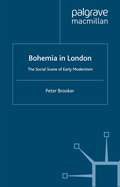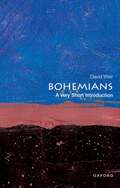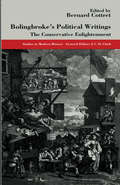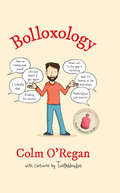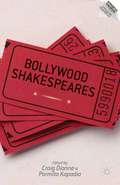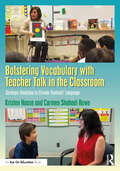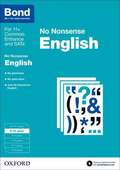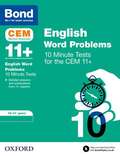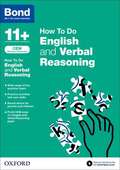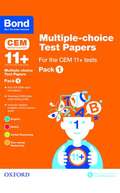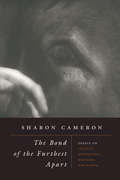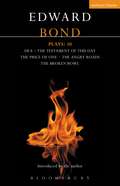- Table View
- List View
Body Work: Objects of Desire in Modern Narrative
by Peter BrooksThe desire to know the body is a powerful dynamic of storytelling in all its forms. Peter Brooks argues that modern narrative is intent on uncovering the body in order to expose a truth that must be written in the flesh. In a book that ranges widely through literature and painting, Brooks shows how the imagination strives to bring the body into language and to write stories on the body.From Rousseau, Balzac, Mary Shelley, and Flaubert, to George Eliot, Zola, Henry James, and Marguerite Duras, from Manet and Gauguin to Mapplethorpe, writers and artists have returned in fascination to the body, the inescapable other of the spirit. Brooks's deep understanding of psychoanalysis informs his demonstration of how the "epistemophilic urge"--the desire to know-guides fictional plots and our reading of them.It is the sexual body that furnishes the building blocks of symbolization, eventually of language itself-which then takes us away from the body. Yet mind and language need to recover the body, as an other realm that is primary to their very definition. Brooks shows how and why the female body has become the field upon which the aspirations, anxieties, and contradictions of a whole society are played out. And he suggests how writers and artists have found in the woman's body the dynamic principle of their storytelling, its motor force.This major book entertains and teaches: Brooks presumes no special knowledge on the part of his readers. His account proceeds chronologically from Rousseau in the eighteenth century forward to contemporary artists and writers. Body Work gives us a set of analytical tools and ideas-primarily from psychoanalysis, narrative and film studies, and feminist theory-that enable us to read modern narrative afresh.
Bohemia in America, 1858–1920
by Joanna LevinBohemia in America, 1858–1920 explores the construction and emergence of "Bohemia" in American literature and culture. Simultaneously a literary trope, a cultural nexus, and a socio-economic landscape, la vie bohème traveled to the United States from the Parisian Latin Quarter in the 1850s. At first the province of small artistic coteries, Bohemia soon inspired a popular vogue, embodied in restaurants, clubs, neighborhoods, novels, poems, and dramatic performances across the country. Levin's study follows la vie bohème from its earliest expressions in the U.S. until its explosion in Greenwich Village in the 1910s. Although Bohemia was everywhere in nineteenth- and twentieth-century American culture, it has received relatively little scholarly attention. Bohemia in America, 1858–1920 fills this critical void, discovering and exploring the many textual and geographic spaces in which Bohemia was conjured. Joanna Levin not only provides access to a neglected cultural phenomenon but also to a new and compelling way of charting the development of American literature and culture.
Bohemia in London: The Social Scene of Early Modernism
by P. BrookerThis original study discovers the bourgeois in the modernist and the dissenting style of Bohemia in the new artistic movements of the 1910s. Brooker sees the bohemian as the example of the modern artist, at odds with but defined by the codes of bourgeois society. It renews once more the complexities and radicalism of the modernist challenge.
Bohemians: : Art And Culture Collide Then Subside On The Monterey Peninsula (VERY SHORT INTRODUCTIONS)
by David WeirThe Romantic myth of Bohemia originated in the early nineteenth century as a way of describing the new conditions faced by artists and writers when the previous system of aristocratic patronage collapsed in the wake of the Age of Revolution. Without the patron system, the artist was free to move around, to seek an audience wherever fortune beckoned. This marketing model likening the artist's vagabond career to the "gypsy" life helps to explain part of the bohemian myth, but not all of it. Most bohemians have scant interest in commercial gain and are not so itinerant after all, confining their movements to down-market urban neighbourhoods where the rent is cheap and the morals are loose. This Very Short Introduction traces the myth of Bohemia through its various fictional manifestations, from Henry Murger's novel Scenes of Bohemian Life (1851) and Giacomo Puccini's opera La Bohème (1896) to Aki Kaurismäki's film La vie de Bohème (1992), and Jonathan Larson's musical Rent (1996). It goes on to examine the history of different bohemian communities, including those in the Latin Quarter of Paris, the Schwabing section of Munich, and the Greenwich Village neighborhood of New York. David Weir also considers the politics of Bohemia and traces the careers of the artists Gustave Courbet and Pablo Picasso and the great chanteuses Yvette Guilbert, Fréhel, and Edith Piaf in the Montmartre neighborhood of Paris, where a rich tradition of popular culture indebted to Bohemia also developed. Weir concludes with a discussion of the legacy of Bohemia today as something outworn and dying, an exhausted tradition that somehow continues.
Bohemians: A Very Short Introduction (VERY SHORT INTRODUCTIONS)
by David WeirThe Romantic myth of Bohemia originated in the early nineteenth century as a way of describing the new conditions faced by artists and writers when the previous system of aristocratic patronage collapsed in the wake of the Age of Revolution. Without the patron system, the artist was free to move around, to seek an audience wherever fortune beckoned. This marketing model likening the artist's vagabond career to the "gypsy" life helps to explain part of the bohemian myth, but not all of it. Most bohemians have scant interest in commercial gain and are not so itinerant after all, confining their movements to down-market urban neighbourhoods where the rent is cheap and the morals are loose. This Very Short Introduction traces the myth of Bohemia through its various fictional manifestations, from Henry Murger's novel Scenes of Bohemian Life (1851) and Giacomo Puccini's opera La Bohème (1896) to Aki Kaurismäki's film La vie de Bohème (1992), and Jonathan Larson's musical Rent (1996). It goes on to examine the history of different bohemian communities, including those in the Latin Quarter of Paris, the Schwabing section of Munich, and the Greenwich Village neighborhood of New York. David Weir also considers the politics of Bohemia and traces the careers of the artists Gustave Courbet and Pablo Picasso and the great chanteuses Yvette Guilbert, Fréhel, and Edith Piaf in the Montmartre neighborhood of Paris, where a rich tradition of popular culture indebted to Bohemia also developed. Weir concludes with a discussion of the legacy of Bohemia today as something outworn and dying, an exhausted tradition that somehow continues.
Bolingbroke's Political Writings: The Conservative Enlightenment (Studies in Modern History)
by Bernard CottretIn turn, Tory minister, Jacobite renegade, English philosopher and anti-minister, Bolingbroke has elicited mixed reactions from his compatriots, both contempories and historians. Bernard Cottret discusses here his political writings in the context of contemporary thought in England and France. His analyses of 'A' Dissertation upon Parties' and 'The Idea of a Patriot King' are supported by a full mid-eighteenth-century political thought.
Bolloxology: An Unreliable Guide To Ireland
by Colm O'ReganLet me ask you a question.Have you ever wondered why pretentiousness, jargon, bullshit and Having Notions Above Our Station are so rife in the world today? Well, there’s now a recognized science that studies all of these forms of self-delusion. Welcome to the world of Bolloxology.We might not know it, but the modern world has subjected all of us to some form of Bolloxology. It’s that moment when you’ve paid twenty euro for fish and chips just so it can be served on a piece of slate. It’s when you share yet another Inspirational Quote of the Day against your better judgement. It’s when you realize you haven’t understood a word That Politician has said to you on your doorstep, yet you feel strangely compelled to take a selfie with him. It’s about the passion, the ‘key learnings’, the artisan chutney, the instacelebs. It’s about the Pure Hames we’re making of things.In Bolloxology, Colm O’Regan, comedian and author of the bestselling Irish Mammies books, shows that our world is now less a planet and more a hot air balloon. Illustrated by the hilarious Twisted Doodles, Bolloxology is an indispensable guide to the deceptive cod-infested seas of twenty-first-century life.
Bollywood Shakespeares (Reproducing Shakespeare)
by Craig Dionne Parmita KapadiaHere, essays use the latest theories in postcolonialism, globalization, and post-nationalism to explore how world cinema and theater respond to Bollywood's representation of Shakespeare. In this collection, Shakespeare is both part of an elite Western tradition and a window into a vibrant post-national identity founded by a global consumer culture.
Bolstering Vocabulary with Teacher Talk in the Classroom: Strategic Modeling to Elevate Students’ Language
by Kristen Haase Carmen Shahadi RoweThis practical guide introduces "Teacher Talk," an easy-to-use tool for teachers to help improve elementary students’ vocabulary. When students are exposed to extensive vocabularies, they are better prepared to build their receptive and productive language and succeed academically. Through many inviting examples and real-world guidance, Rowe and Haase explain how to be reflective and intentional about the language you use and how to use elevated or substitutionary language to model different registers of speech for elementary students. The various "Teacher Talk" strategies in this book cover key topics, including disciplinary vocabulary, modelling academic discourse, addressing state and national standards, and meeting individual student needs across grades K–6. With many charts, activities, and tools that are ready for use, this book equips teachers with many methods for bolstering students’ academic language in the classroom and beyond.
Bolstering Vocabulary with Teacher Talk in the Classroom: Strategic Modeling to Elevate Students’ Language
by Kristen Haase Carmen Shahadi RoweThis practical guide introduces "Teacher Talk," an easy-to-use tool for teachers to help improve elementary students’ vocabulary. When students are exposed to extensive vocabularies, they are better prepared to build their receptive and productive language and succeed academically. Through many inviting examples and real-world guidance, Rowe and Haase explain how to be reflective and intentional about the language you use and how to use elevated or substitutionary language to model different registers of speech for elementary students. The various "Teacher Talk" strategies in this book cover key topics, including disciplinary vocabulary, modelling academic discourse, addressing state and national standards, and meeting individual student needs across grades K–6. With many charts, activities, and tools that are ready for use, this book equips teachers with many methods for bolstering students’ academic language in the classroom and beyond.
Bond: 9-10 years
by Frances OrchardBond English No Nonsense for 9-10 years has been designed by Bond to provide a thorough grounding in core English skills for children in Key Stage 2. Matched to the National Curriculum, No Nonsense books can be used to reinforce school learning, help children to get ahead in class and boost performance in SATs, 11+ and Common Entrance assessment.
Bond 11+: 9-10 years (PDF)
by Michellejoy HughesBond is the number 1 provider of 11+ practice, helping millions of children pass selective entrance exams. Bond Comprehension Papers for 9-10 Years is essential for building comprehension skills in preparation for the 11+, Common Entrance examinations and SATs. This practical guide follows an accessible, step-by-step approach to developing these key skills.
Bond 11+: 10-11 Years
by Michellejoy HughesBond 11+ CEM English Word Problems 10 Minute Tests for 10-11 year olds have been designed by Bond, the number one provider of 11+ practice materials. This book provides practice of English Word Problem questions, which regularly feature in CEM exams.
Bond 11+: How To Do English And Verbal Reasoning
by Michellejoy Hughes Bond 11+Bond How to Do English and Verbal Reasoning has been designed by Bond, the number 1 provider of 11+ practice materials. This book provides expert advice and step-by-step strategies that begin to establish the core skills for success in the English and Verbal Reasoning CEM exams.
Bond 11+: 10-11 Years
by Christine JenkinsBond 11+ CEM Comprehension 10 Minute Tests for 10-11 year olds have been designed by Bond, the number one provider of 11+ practice materials. This book provides practice of Comprehension questions, which regularly feature in CEM exams.
Bond 11+ English Assessment Papers
by Sarah LindsayBond is the number 1 provider of 11+ practice, helping millions of children pass selective entrance exams. Bond English Assessment Papers for 9-10 years Book 1 are topic-based practice questions for the 11+ exam. They have been written to cover the core 11+ question types your child will experience in their actual exam, building the skills and confidence for exam success. Bond English Assessment Papers for 9-10 years Book 2 (ISBN: 9780192740045) is also available.
Bond 11+ English Assessment Papers (PDF)
by Sarah LindsayBond is the number 1 provider of 11+ practice, helping millions of children pass selective entrance exams. Bond English Assessment Papers for 9-10 years Book 1 are topic-based practice questions for the 11+ exam. They have been written to cover the core 11+ question types your child will experience in their actual exam, building the skills and confidence for exam success. Bond English Assessment Papers for 9-10 years Book 2 (ISBN: 9780192740045) is also available.
Bond 11+: Multiple-choice Test Papers for the CEM 11+ Tests Pack 1
by Michellejoy Hughes Bond 11+Bond Practice Test Papers are specifically designed with CEM test preparation in mind, but they are also suitable for any 11 plus exam. The mixed-subject test paper format helps build confidence in key areas.
The Bond of the Furthest Apart: Essays on Tolstoy, Dostoevsky, Bresson, and Kafka
by Sharon CameronIn the French filmmaker Robert Bresson’s cinematography, the linkage of fragmented, dissimilar images challenges our assumption that we know either what things are in themselves or the infinite ways in which they are entangled. The “bond” of Sharon Cameron’s title refers to the astonishing connections found both within Bresson’s films and across literary works by Tolstoy, Dostoevsky, and Kafka, whose visionary rethinkings of experience are akin to Bresson’s in their resistance to all forms of abstraction and classification that segregate aspects of reality. Whether exploring Bresson’s efforts to reassess the limits of human reason and will, Dostoevsky’s subversions of Christian conventions, Tolstoy’s incompatible beliefs about death, or Kafka’s focus on creatures neither human nor animal, Cameron illuminates how the repeated juxtaposition of disparate, even antithetical, phenomena carves out new approaches to defining the essence of being, one where the very nature of fixed categories is brought into question. An innovative look at a classic French auteur and three giants of European literature, The Bond of the Furthest Apart will interest scholars of literature, film, ethics, aesthetics, and anyone drawn to an experimental venture in critical thought.
The Bond of the Furthest Apart: Essays on Tolstoy, Dostoevsky, Bresson, and Kafka
by Sharon CameronIn the French filmmaker Robert Bresson’s cinematography, the linkage of fragmented, dissimilar images challenges our assumption that we know either what things are in themselves or the infinite ways in which they are entangled. The “bond” of Sharon Cameron’s title refers to the astonishing connections found both within Bresson’s films and across literary works by Tolstoy, Dostoevsky, and Kafka, whose visionary rethinkings of experience are akin to Bresson’s in their resistance to all forms of abstraction and classification that segregate aspects of reality. Whether exploring Bresson’s efforts to reassess the limits of human reason and will, Dostoevsky’s subversions of Christian conventions, Tolstoy’s incompatible beliefs about death, or Kafka’s focus on creatures neither human nor animal, Cameron illuminates how the repeated juxtaposition of disparate, even antithetical, phenomena carves out new approaches to defining the essence of being, one where the very nature of fixed categories is brought into question. An innovative look at a classic French auteur and three giants of European literature, The Bond of the Furthest Apart will interest scholars of literature, film, ethics, aesthetics, and anyone drawn to an experimental venture in critical thought.
The Bond of the Furthest Apart: Essays on Tolstoy, Dostoevsky, Bresson, and Kafka
by Sharon CameronIn the French filmmaker Robert Bresson’s cinematography, the linkage of fragmented, dissimilar images challenges our assumption that we know either what things are in themselves or the infinite ways in which they are entangled. The “bond” of Sharon Cameron’s title refers to the astonishing connections found both within Bresson’s films and across literary works by Tolstoy, Dostoevsky, and Kafka, whose visionary rethinkings of experience are akin to Bresson’s in their resistance to all forms of abstraction and classification that segregate aspects of reality. Whether exploring Bresson’s efforts to reassess the limits of human reason and will, Dostoevsky’s subversions of Christian conventions, Tolstoy’s incompatible beliefs about death, or Kafka’s focus on creatures neither human nor animal, Cameron illuminates how the repeated juxtaposition of disparate, even antithetical, phenomena carves out new approaches to defining the essence of being, one where the very nature of fixed categories is brought into question. An innovative look at a classic French auteur and three giants of European literature, The Bond of the Furthest Apart will interest scholars of literature, film, ethics, aesthetics, and anyone drawn to an experimental venture in critical thought.
The Bond of the Furthest Apart: Essays on Tolstoy, Dostoevsky, Bresson, and Kafka
by Sharon CameronIn the French filmmaker Robert Bresson’s cinematography, the linkage of fragmented, dissimilar images challenges our assumption that we know either what things are in themselves or the infinite ways in which they are entangled. The “bond” of Sharon Cameron’s title refers to the astonishing connections found both within Bresson’s films and across literary works by Tolstoy, Dostoevsky, and Kafka, whose visionary rethinkings of experience are akin to Bresson’s in their resistance to all forms of abstraction and classification that segregate aspects of reality. Whether exploring Bresson’s efforts to reassess the limits of human reason and will, Dostoevsky’s subversions of Christian conventions, Tolstoy’s incompatible beliefs about death, or Kafka’s focus on creatures neither human nor animal, Cameron illuminates how the repeated juxtaposition of disparate, even antithetical, phenomena carves out new approaches to defining the essence of being, one where the very nature of fixed categories is brought into question. An innovative look at a classic French auteur and three giants of European literature, The Bond of the Furthest Apart will interest scholars of literature, film, ethics, aesthetics, and anyone drawn to an experimental venture in critical thought.
The Bond of the Furthest Apart: Essays on Tolstoy, Dostoevsky, Bresson, and Kafka
by Sharon CameronIn the French filmmaker Robert Bresson’s cinematography, the linkage of fragmented, dissimilar images challenges our assumption that we know either what things are in themselves or the infinite ways in which they are entangled. The “bond” of Sharon Cameron’s title refers to the astonishing connections found both within Bresson’s films and across literary works by Tolstoy, Dostoevsky, and Kafka, whose visionary rethinkings of experience are akin to Bresson’s in their resistance to all forms of abstraction and classification that segregate aspects of reality. Whether exploring Bresson’s efforts to reassess the limits of human reason and will, Dostoevsky’s subversions of Christian conventions, Tolstoy’s incompatible beliefs about death, or Kafka’s focus on creatures neither human nor animal, Cameron illuminates how the repeated juxtaposition of disparate, even antithetical, phenomena carves out new approaches to defining the essence of being, one where the very nature of fixed categories is brought into question. An innovative look at a classic French auteur and three giants of European literature, The Bond of the Furthest Apart will interest scholars of literature, film, ethics, aesthetics, and anyone drawn to an experimental venture in critical thought.
The Bond of the Furthest Apart: Essays on Tolstoy, Dostoevsky, Bresson, and Kafka
by Sharon CameronIn the French filmmaker Robert Bresson’s cinematography, the linkage of fragmented, dissimilar images challenges our assumption that we know either what things are in themselves or the infinite ways in which they are entangled. The “bond” of Sharon Cameron’s title refers to the astonishing connections found both within Bresson’s films and across literary works by Tolstoy, Dostoevsky, and Kafka, whose visionary rethinkings of experience are akin to Bresson’s in their resistance to all forms of abstraction and classification that segregate aspects of reality. Whether exploring Bresson’s efforts to reassess the limits of human reason and will, Dostoevsky’s subversions of Christian conventions, Tolstoy’s incompatible beliefs about death, or Kafka’s focus on creatures neither human nor animal, Cameron illuminates how the repeated juxtaposition of disparate, even antithetical, phenomena carves out new approaches to defining the essence of being, one where the very nature of fixed categories is brought into question. An innovative look at a classic French auteur and three giants of European literature, The Bond of the Furthest Apart will interest scholars of literature, film, ethics, aesthetics, and anyone drawn to an experimental venture in critical thought.
Bond Plays: Dea; The Testament of this Day; The Price of One; The Angry Roads; The Hungry Bowl (Contemporary Dramatists)
by Edward BondBond Plays: 10 brings together recent work by the writer of the classic stage plays Saved, Lear, The Pope's Wedding and Early Morning. The volume comprises four previously unpublished plays, one previously published play and a comprehensive introduction by the author.Dea, a heroine, has committed a terrible act and has been exiled. When she meets someone from her past, she is forcefully confronted by the broken society that drove her to commit her crimes. In this play, Edward Bond takes from the Greek and Jacobean drama the fundamental classical problems of the family and war to vividly picture our collapsing society. Dea received its premiere at Sutton Theatre in 2016.The Testament of this Day is Edward Bond's third original radio drama. A young man embarks on two journeys, though he is in control of only one. He soon discovers there is no going back, from either. The play is an arresting drama about the world today and was first produced by BBC Radio 4 in 2016.The Price of One is set in among city ruins in a war zone. An occupying soldier carries a baby he has rescued from the rubble and dust. He meets a woman carrying a baby of her own. What ensues is a struggle between two enemies demanding justice in the midst of war. A modern tragedy, this play is an exploration of eternity and madness and the supermarket culture. It received its premiere in 2016.The Angry Roads considers how young people today grow up in a world that their parents never knew. In a flat a teenage boy is sorting through play things from his childhood; he is sorting through his past in search of the truth about an accident that destroyed his family. The Angry Roads was commissioned by Big Brum Theatre Company and premiered in 2015.The Hungry Bowl is a portrait of a a ghost town. Outside a harsh wind rattles the windows. Inside, people go hungry and start boarding up their homes. When a young girl insists on feeding her imaginary friend, a bitter struggle for a future ensues for the power of the imagination to transform lives. The play is a moving and audacious modern fable that explores the impact of hard times on family life, commissioned by Big Brum and premiered in 2012.The volume features an introduction by the author that looks at theatre and culture in a post-Brexit referendum, post-truth and post-Trump era.


